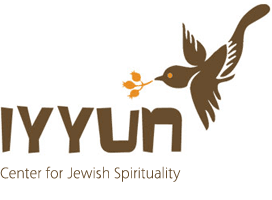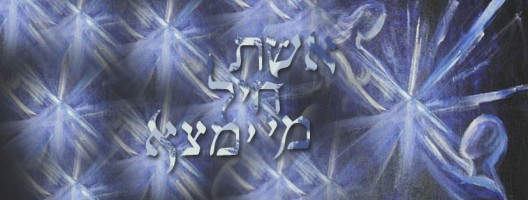The Aishes Chayil
The Root of Soul-Mates & the Feminine Quality
There is a beautiful Friday evening tradition to recite a uniquely poetic portion from the Book of Proverbs right before Kiddush, at the Shabbat table. The poetic verses are known as the Aishes Chayil or “Woman of Valorâ€.
The Aishes Chayil is comprised of twenty-two verses, each verse beginning with another letter of the Aleph-Bet, forming an acrostic of the Hebrew alphabet.
The poem, which speaks of the inner qualities and external manifestations of the archetypal Woman of Valor or Aishes Chayal, was understood throughout history as a multi-dimensional allegory that simultaneously alludes to the nature of the Soul, Wisdom, Torah, Shechinah (the Divine Feminine Presence), and Shabbos.
Yet, on the simplest level, the poem refers to a woman. In fact, one Midrashic reading implies that the twenty-two verses are actually referring to twenty-two of the most powerful and important women of Jewish history.
Over the course of the past few hundred years the custom has developed for the man of the home to sing this poem at the end of the work week, as the family is about to participate in the festive Shabbos meal, in honor of the gifts of the woman of the home. This humble ritual act expresses our deepest felt gratitude for everything that she has done for the family.
Shabbat — The Feminine Quality
Shabbat — our day of rest, reflection, and rejuvenation — is deeply related to the concept of the Feminine.
Furthermore, the Feminine is associated with the very essence of the home — a peaceful and secure place permeated by a sanctified presence within which we find stability and security while being nourished on the deepest levels of our being. Our home is the center of our gravity. It focuses us and grounds us. The woman of the home, like Shabbat, is understood as the foundation of the familial enterprise, which in turn is understood as the very soil in which the fruits of our labors begin to take root.
Shabbat is referred to as “the Queenâ€, she is also known as the Sabbath Bride. This indicates that Shabbat is our spiritual soul-mate. During Kabbalat Shabbat, the service of “Receiving the Shabbatâ€, we welcome her into our lives with spirited song, dance, and celebration.
Alternately, in relation to Hashem (The King), we ourselves are like Shabbat, and our soul is characterized as the Queen or Bride of the Creator. Our sages express this symbolic relationship in the story of a King who sought to create a beautiful bridal chamber. It was designed, adorned, and decorated immaculately. There was but one element missing — the Bride. Shabbat is that bride — our soul is that bride. And there is no King, no ruler, except for the Infinite One.
Kabbalat Shabbat — Receiving the Bride
In Talmudic times there were sages who would dress in their finest attire and sing, “let us go out to greet the Shabbos queen,†as well as chanting “come O bride, come O bride†(Shabbos, 119a). During the medieval period, a ritual custom was developed to enhance the liminal moments as Shabbos was beginning (and ending) with song and dance, as would befit the entrance and exit of a Queen (Sefer Hamanhig).
As the sun was setting over the hilltops, the AriZal (Rabbi Issac Luria) and many other mystics of that generation, would venture out into the open fields, or gather at one of the magnificent slopes to open their minds and hearts in joyous longing and festive song to greet the Shabbos Bride. It was during this time that the order of poems and Psalms now known as “Kabbalat Shabbat†was set in place.
In G-d’s Image They Were Created
In psycho-symbolic terminology, each one of us possesses both masculine (assertive) and feminine (receptive) qualities.
(NOTE: This one-dimensional, black and white, polarized categorization of the concepts of “masculine†and “feminine†is in no way to be mistaken for a characterization of physical “gender†as it manifests in bodily form. Furthermore, it must be reiterated that we are all comprised of both “masculine†and “feminine†energies and attributes.)
The externally directed, masculine tendency is exercised and activated during the six days of the week. For a psycho-celestial cycle of six days we create, we manipulate, and we aspire to ‘change’ and mold nature. On Shabbat, the Seventh Day, we rest, we stop, we cease, we pause, and we move inward and open ourselves up to receive. It is during Shabbat that we attempt to submit ourselves in reflective acknowledgement and prayerful appreciation for Creation as it is in the Present Moment, no longer needing to change anything.
During the week we are devoted to “masculine†pursuits, as it were, mastering and manipulating the elements of creation, molding them to our will. On Shabbat we enter a more “feminine†quality, we cease conquering the world around us, and relinquish our obsession and attachment to control. We aim to settle and allow ourselves to be still.
Present & Future
Shabbat is both a place (or time) to come to, a destination — as in the rest that culminates six days of hard work — and a place to come from, a beginning — as in the gestation period that gives focus and trajectory to our coming week. In this sense we can see that the Feminine is both the foundation and the catapult of the Masculine, stabilizing as well as stirring.
Shabbat absorbs and assimilates the previous week, as well as impregnates and influences the following week. The Feminine as it exists within each one of us— expressing itself within in all of our different relationships and energetic exchanges — absorbs and assimilates the struggles and strivings of the Masculine, impregnating the present by integrating the past within the possibility for a renewed future.
Soul Mates: Our ‘First’ and ‘Second’ Match
Aishes Chayal is a wonderful and deep poem that demands an entire book to truly explore, but for our purposes, let us focus on the opening words of the poem and unearth some of its deeper wisdom.
The poem opens with the words: “A woman of valor, who can find?â€
Is this meant to be a rhetorical question or an actual inquiry? Is the poet asking: “Who can find a woman of valor?†Or, is it that having found his ‘woman of valor’, he is saying: “Who could ever imagine that I would actually find my perfect match?â€
To explore this further, let us begin with a passage in the Talmud:
Reish Lakish expounded and said: “They only pair a woman with a man according to his deeds.†Rav Yehudah said: “Forty days before the creation of a child, a Heavenly Voice issues forth and proclaims: ‘The daughter of so and so is destined to marry so and so’â€
In this, there is no contradiction. The latter teaching refers to a ‘first match’ and the former to a ‘second match’†(Sotah, 2a).
It appears that the concept of the ‘first match’ represents entering into a relationship that was ‘meant to be’, i.e. founded on Heavenly decree. The ‘second match’ — supposing one marries twice — is based on merit, personality, and actions. In summary: ‘first match’ would be analogous to Divine Providence, and ‘second match’ would be analogous to Free Will.
These concepts, ‘first’ and ‘second’ match, however, do not necessarily always refer to a linear order of relationship (as in a chronological first and second partner), but rather, they can refer more to an ontological order, wherein the ‘firstborn’ relationship is set aside for someone based on Heavenly decree, and the ‘second temple’ relationship is arrived at due to a person’s own choices and decisions. Seen from this perspective, it becomes clear that there are multiple paths to arrive at a singular destination, in this case, true unification with your soul-mate.
Furthermore, this metaphor can be understood on a deeper level when we compare two stories that depict the ways in which the Children of Israel accepted the Torah. The first story, based on a Midrash, describes Hashem as ‘holding Mt. Sinai over the heads of the Israelites’, effectively forcing them to accept the Torah. Due to this Heavenly coercion, the sages learn that we did not fully accept the Divine Decree during the overpowering revelation at Sinai. It was only during the time of Esther and Mordechai, in the Purim story, in which the name of G-d is conspicuously absent, that the Children of Israel willingly, and with full consciousness, took on the obligations of the Torah through their own resolve.
Still another way to understand this concept of ‘first’ and ‘second matches’ is how these two archetypes can both play out in a single relationship. As our souls become embodied we are given a soul-mate, a ‘first match’, who if we marry will be our perfect match based on the original nature of our eternal soul. But we are only able to ‘receive’ our soul-mate if we ‘deserve’ it. We ‘earn’ our rightful soul-mate when we do the internal work necessary to recognize them when they appear to us in temporal form. We have to be open, sensitive, and ready for the deep work of bringing ‘two into one’. This work often entails more than ‘finding the right person’. One must actually ‘be the right person’ in order to recognize and be recognized.
This dynamic can be illustrated by a Midrash which reports how the Sea of Reeds was created solely on the condition that it would part for the Israelites as they were escaping their enslavement in Egypt. As the pre-destined time approached and the Israelites stood on the shore of the sea, the waters refused to part. The sea only split for the Israelites once their true nature was revealed through a heroic act of ultimate faith. As the Egyptian army was approaching from behind, and the sea remained in front of them, blocking their way to freedom, Nachshon, a member of the tribe of Judah, walked straight into the sea. The waters finally parted as they reached his nose. This is a beautiful example of a Divinely decreed event occurring only on the merit of one’s actions. This is more fully articulated when one considers the saying of the sages that, “finding one’s soul-mate is as big of a miracle as the splitting of the sea.â€
The Roots of our Soul:
The concept of soul–mates is intricately connected with the concept of ‘soul roots’ within the primordial human — Adam.
Adam, the way he is described at the genesis of creation, is both male and female. Physically and metaphysically the prototypical human being was neither all male nor all female, but rather a synthesis of both the male and female aspects.
Physicality is a reflection of spiritual reality. As Adam is understood as the physical parent of humankind, so is Adam also our spiritual parent. Adam’s soul represents the original collective soul from where all later souls emanate — a Source Soul from which all individualized souls are derivatives.
One’s body is the physical imprint of their soul. Body and soul mirror and reflect each other. The form of Adam’s body was analogous to the spiritual structure of his soul. As the physical body can be divided into various compartments, the same is true with regard to the soul. There are souls that are rooted in the ‘head’ of Adam and there are souls who stem from the ‘hands’ of Adam, there are souls who come from the ‘heart’, and souls that come from the ‘feet’. Accordingly, ‘head’ souls are inclined towards more intellectual pursuits, ‘hand’ souls show signs of physical dexterity and craftsmanship, ‘heart’ souls are brimming with emotions and empathy and ‘feet’ souls are action or movement oriented.
Our perfect ‘first match’ is known as our counterpart (male or female) soul from within the ‘body’ of Adam. This means that if we are primarily a ‘head’ or ‘heart’ soul, our ‘first match’ will also be a soul from Adam’s ‘head’ or ‘heart’, but from the opposite side of the ‘body’, so to speak. For instance if one is a ‘hand’ soul, their ‘first match’ counterpart would also be a ‘hand’ soul, but one partner would be from the right hand of ‘Adam’ (Chesed) and their partner would be from the ‘left hand’ (Gevurah). Another way to dichotomize this dynamic would be to say that one soul is from the ‘masculine’ side, while the other soul is from the ‘feminine’ side within the specific area of the primordial body. In this way, ‘first match’ souls are ‘opposite’ each other. This dynamic is manifest as a kind of symmetrical equilibrium, thus creating a balance of energies and capacities that complement each other’s specific gifts.
Our ‘second match’ is most often found in souls that are more similar to our own soul-root, rather than being a more contrasting counterpart. This means that if we are ‘head’ souls, our ‘second match’ soul-mate would also be a head soul, but instead of each partner being rooted in an opposite ‘side of the brain’ (so to speak), each partner would be from the same ‘side of Adam’s brain’. This dynamic is present in relationships where each party shares many common interests, activities, and even approaches to life in general. Rather than balancing each other out, ‘second match’ partners reflect and reinforce each other’s energies in more of a mirroring quality. In this respect, each partner is looking to unite with someone who is ‘created in their own image’, so to speak.
To further illustrate this dynamic we can turn to a fascinating phrase in Genesis and it’s illuminating explication from the Gemarah. The Torah states that Chava was an Ezer K’negdo to Adam. This mysterious description is often translated as a “helper for himâ€, but when rendered literally according to the Hebrew it more accurately means a “helper against himâ€. The Sages interpret this to mean that a wife can be either an Ezer/Helper, or K’negdo/Against him, depending on how the couple relates to each other.
And yet on the deepest level we can see that a partner may actually become a ‘helper’ by being an ‘opposite’. This is the characterization of the ‘first match’ soul-mate. In the case of the ‘second match’ soul-mate, each partner is more of an Ezer/Helper, without so much K’negdo/Oppositonal energy. The relationship is characterized more by each partner supporting the other in complementary growth rather than challenging each other by providing an equal and opposite aspect of a similar soul-root.
In summary, a ‘first match’ soul-mate challenges one to grow and evolve, through the process of relationship and unification with an ‘other’, into a more comprehensive and balanced individual. By providing each other with a countervailing force to wrestle against and align with, each partner is able to both highlight and call forth the unique talents of the other, while also illuminating the darker areas in which one needs support and encouragement in order to become the best person they can be.
A ‘second match’ soul-mate is more likely to connect with and reinforce one’s current level and perspective. This is not to say that a ‘second match’ relationship will not engender growth. But it may occur more along the lines of both partners growing together in similar ways, rather than both partners growing in opposing ways, together.
Either relationship or approach has the infinite potential to provide each partner with the conditions and consciousness necessary to evolve further into the person they came here to be. And indeed, as noted earlier, a single relationship may very well include both of these dynamics at one or different times depending on the circumstances.
Prayer or Acknowledgment
And so we return to our initial discussion of the Aishes Chayal.
As one is about to begin the Friday night meal, sitting down to a beautifully set table, fully prepared to usher in and celebrate the entrance of the perfect soul-mate of the Jewish people, the holy Shabbos Bride, one recites this poem, and begins: “A woman of valor, who can find�
For the one who is still looking to find his perfect soul-mate, the Aishes Chayal is a prayer of yearning. He begins by saying: “A woman of valor, who can find?†This short opening line poetically expresses an active search for the perfect match, his soul-mate. He is looking to ‘find’ her because she has been ‘lost’, or has yet to have been acknowledged.
But for the one who has found his perfect match, as he is poised to enter into blissful union with the cosmic bride of Shabbos, he pauses to acknowledge the Divine Presence within his holy wife and healthy family. He takes a look around the Shabbos table and is filled with praise, thanks, and gratitude for finding his perfect soul-mate.







